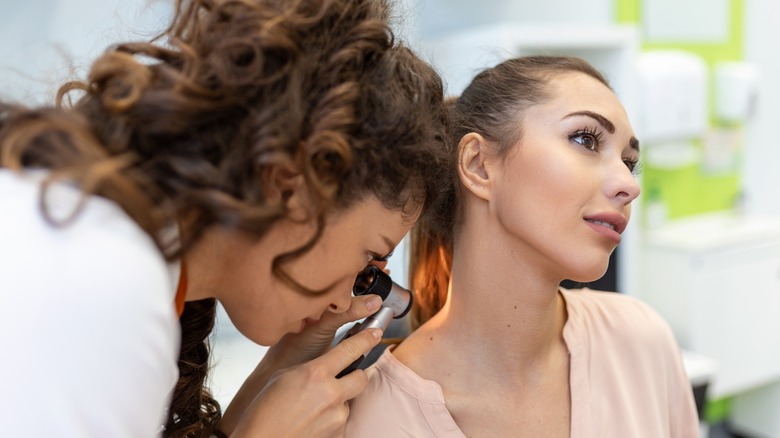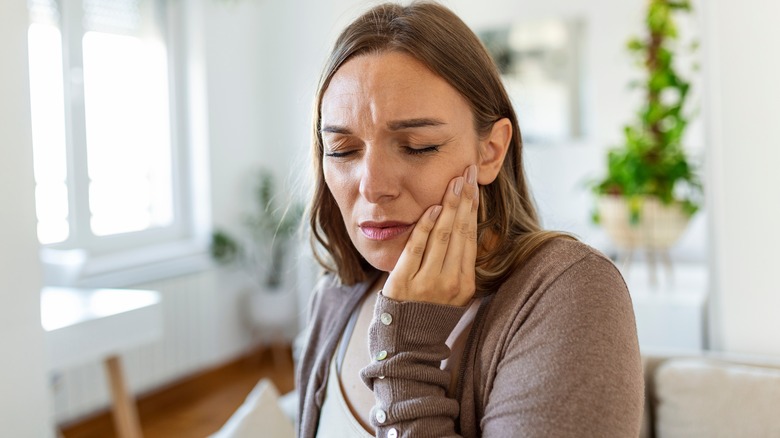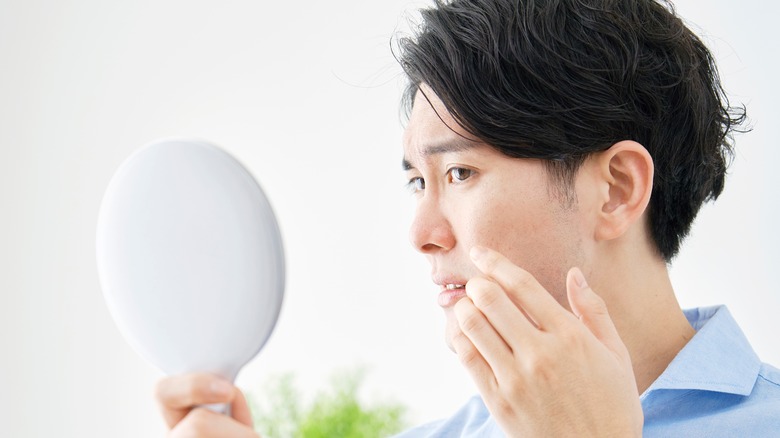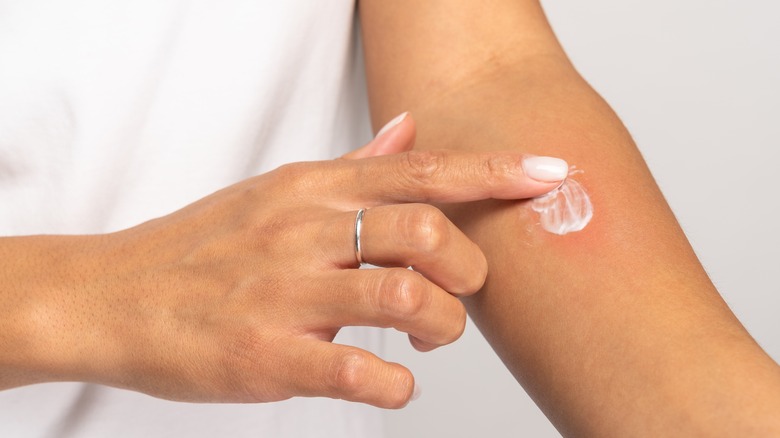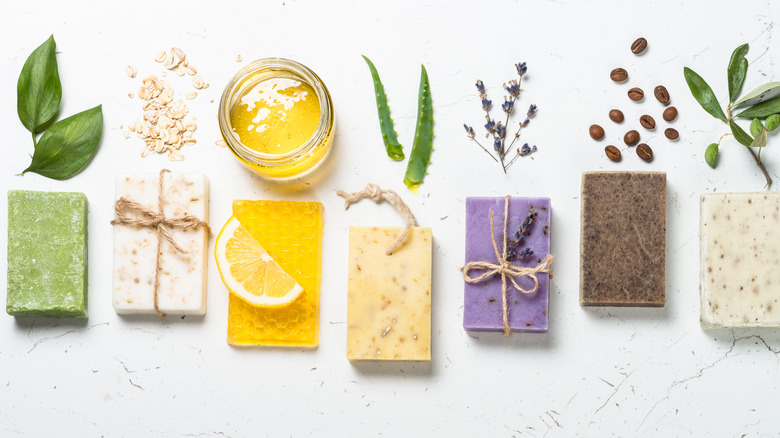Sebaceous Cysts: The Complete Guide
The human skin comprises tiny sacs of hair follicles surrounded by sebaceous glands that secrete sebum, according to "Atlas of Head and Neck Pathology" (via The Ohio State University College of Medicine). The job of sebum is to lubricate both the hair and the skin. However, when the gland becomes blocked, a lump forms under the skin called a sebaceous cyst, says Healthline.
According to MedicalNewsToday, sebaceous cysts, also known as keratin cysts, epidermal cysts, or epithelial cysts, are slightly hardened fluid-filled bumps. According to the source, most nodules resemble closed sacs beneath the skin, and although they're mostly a few millimeters, they can grow to 5 centimeters. They often appear on the neck, torso, and face and affect around 20% of adults, says Medical News Today. Although they are more common in adults, children can also have sebaceous cysts, according to Mount Sinai Hospital. According to the hospital, a tiny hole or pit can sometimes be seen in the center.
Symptoms of sebaceous cysts
According to the Cleveland Clinic, the main symptom of sebaceous cysts is a small lump beneath the skin. According to the source, this lump usually comes with zero pain. Although rare, some sebaceous cysts can get inflamed. In such instances, the skin around the area of the cyst might be red or warm to the touch, says the clinic. The larger the cysts, the more uncomfortable or painful the cyst might feel, according to Healthline. Furthermore, cysts on the neck and face might cause some pressure, which can translate into pain, per the source.
To understand whether or not your cyst is cancerous, there are certain symptoms you should look out for. According to Healthline, if your cyst has a diameter of more than 5 centimeters, it might be cancerous and should be checked. Other signs to look out for are if the cyst reoccurs after its removal (and the rate at which it reoccurs) and if the cyst shows signs of an infection, such as pain, redness, and pus drainage. According to Mount Sinai Hospital, infected cysts might also exhibit signs such as grayish-white, cheesy, foul-smelling material that drains from the cysts.
Causes of sebaceous cysts
According to MedicalNewsToday, skin cysts often develop when our cells multiply and, instead of moving outward, move inward away from the skin's surface. Sebaceous cysts can emerge due to damage that causes top-layer cells to be implanted within the lower layer of our skin. Cleveland Clinic states that sebaceous cysts originate from the sebaceous gland. Cysts can form when this gland or the duct through which sebum leaves the skin is blocked or damaged. According to the clinic, the damage or blockage can result from trauma to the skin from a surgical wound, a scratch, or a skin condition like acne. Sebaceous cysts can also emerge due to a deformed duct or a genetic condition like basal cell nevus syndrome, says the clinic.
Sometimes, sebaceous cysts can occur for no clear reason. This is most common with people whose family has a history of sebaceous cysts, says Johns Hopkins Medicine. According to the source, the cysts, in this case, usually contain lipids, keratin, and other skin particles. Sebaceous cysts start growing, remain stable for a while, and in some cases, continue to grow. They're usually not a cause for alarm until they inflame and suddenly rupture, increasing the chance of an infection.
Diagnosis and tests
According to the Cleveland Clinic, people often mistake sebaceous cysts (formed in the sebaceous glands) for epidermoid cysts (formed on the skin). Both are different, with sebaceous cysts being far less common than epidermoid cysts. Although sebaceous cysts often exhibit a slightly yellowish color, a pathologist must officially diagnose the issue by examining the cyst after its removal. In certain cases, the removed cysts then undergo a biopsy to rule out other skin growths, says the clinic.
In certain cases where the cyst is atypical, more tests might be needed to rule out cancer, per Healthline. Tests are also needed before the cyst can be removed. According to Healthline, common tests include a CT scan (which helps decide the best surgery route), an ultrasound (to understand the content of the cysts), and a punch biopsy (to examine the cyst for any cancerous characteristics).
If any form of infection is suspected, you might need a skin culture, says Mount Sinai Hospital. According to the source, this laboratory test helps identify which germs are causing the problem.
Medical treatment options
According to the Cleveland Clinic, sebaceous cysts can be ignored if they're small, not growing, and aren't bothersome (since cysts aren't usually dangerous). In the case of an infected cyst, an injection with a steroid drug might help the swelling reduce, says the clinic. The cyst might also need draining if it is large, tender, or inflamed. If you'd like the cyst to be surgically removed, this is known as an excision. Various different excision methods exist (via Healthline).
According to the source, the first is the laser-aided excision, where the cyst is drained after the laser makes a small hole. There's also the conventional wide excision, which can leave a long scar after the cyst is removed. Lastly, the laser with punch biopsy excision will require a small hole to be made on the skin to drain the pus out.
In the event of an infection, your doctor might give you an antibiotic ointment to reduce any symptoms, says MedicalNewsToday. If the antibiotics don't work, treatment might include surgery. During the surgery, your skin will be numb with help from a local anesthetic before the cut is made in the skin and the cyst squeezed out, explains the National Health Service (NHS). According to the source, cyst removal surgeries often leave scars. Furthermore, cysts removed from the scrotum and scalp have a higher chance of growing back, says the NHS.
At-home treatment options
According to MedicalNewsToday, keeping the cyst clean is the best and most appropriate home remedy. The source advises practicing good hygiene, especially after the cyst is removed. This will reduce the chances of an infection and also prevent the cyst from returning. When cleaning the cyst, ensure you use a clean cloth or cotton wool and apply gentle strokes of warm water before dabbing it dry.
To reduce inflammation, a warm towel held against the cysts for some minutes will also come in handy, says the Cleveland Clinic. According to Healthline, tea tree oil might also help. According to a 2006 study published in the journal Clinical Microbiology Reviews, tea tree oil possesses strong antimicrobial activity, killing viruses, bacteria, fungi, and various other pathogens.
Lastly, Healthline also recommends using aloe vera to help relieve the pain and irritation the cysts might come with. Aloe vera has antimicrobial and anti-inflammatory properties that help with skin irritations and cyst pain. Healthline mentions you can use a pure aloe vera gel, a lotion, or a cream, applying it directly on the irritated cyst as often as needed.

